odometer BUICK TERRAZA 2007 Owner's Manual
[x] Cancel search | Manufacturer: BUICK, Model Year: 2007, Model line: TERRAZA, Model: BUICK TERRAZA 2007Pages: 562, PDF Size: 2.96 MB
Page 167 of 562
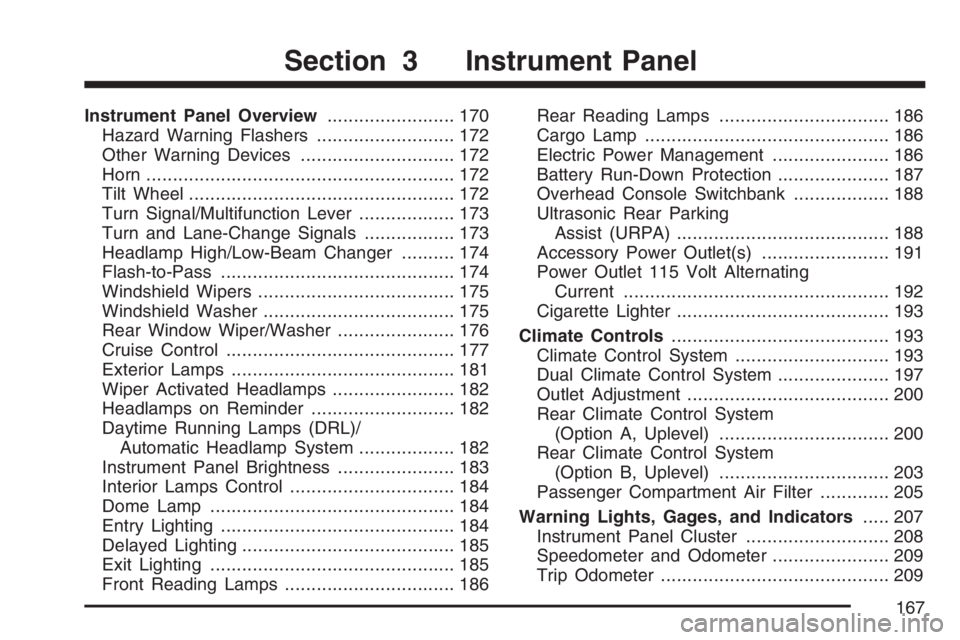
Instrument Panel Overview........................ 170
Hazard Warning Flashers.......................... 172
Other Warning Devices............................. 172
Horn.......................................................... 172
Tilt Wheel.................................................. 172
Turn Signal/Multifunction Lever.................. 173
Turn and Lane-Change Signals................. 173
Headlamp High/Low-Beam Changer.......... 174
Flash-to-Pass............................................ 174
Windshield Wipers..................................... 175
Windshield Washer.................................... 175
Rear Window Wiper/Washer...................... 176
Cruise Control........................................... 177
Exterior Lamps.......................................... 181
Wiper Activated Headlamps....................... 182
Headlamps on Reminder........................... 182
Daytime Running Lamps (DRL)/
Automatic Headlamp System.................. 182
Instrument Panel Brightness...................... 183
Interior Lamps Control............................... 184
Dome Lamp.............................................. 184
Entry Lighting............................................ 184
Delayed Lighting........................................ 185
Exit Lighting.............................................. 185
Front Reading Lamps................................ 186Rear Reading Lamps................................ 186
Cargo Lamp.............................................. 186
Electric Power Management...................... 186
Battery Run-Down Protection..................... 187
Overhead Console Switchbank.................. 188
Ultrasonic Rear Parking
Assist (URPA)........................................ 188
Accessory Power Outlet(s)........................ 191
Power Outlet 115 Volt Alternating
Current.................................................. 192
Cigarette Lighter........................................ 193
Climate Controls......................................... 193
Climate Control System............................. 193
Dual Climate Control System..................... 197
Outlet Adjustment...................................... 200
Rear Climate Control System
(Option A, Uplevel)................................ 200
Rear Climate Control System
(Option B, Uplevel)................................ 203
Passenger Compartment Air Filter............. 205
Warning Lights, Gages, and Indicators..... 207
Instrument Panel Cluster........................... 208
Speedometer and Odometer...................... 209
Trip Odometer........................................... 209
Section 3 Instrument Panel
167
Page 187 of 562

The battery can be discharged at idle if the electrical
loads are very high. This is true for all vehicles. This
is because the generator (alternator) may not be
spinning fast enough at idle to produce all the power
that is needed for very high electrical loads.
A high electrical load occurs when several of the
following loads are on: headlamps, high beams,
fog lamps, rear window defogger, climate
control fan at high speed, heated seats, engine
cooling fans, trailer loads, and loads plugged into
accessory power outlets.
EPM works to prevent excessive discharge of the
battery. It does this by balancing the generator’s
output and the vehicle’s electrical needs. It
can increase engine idle speed to generate more
power, whenever needed. It can temporarily
reduce the power demands of some accessories.
Normally, these actions occur in steps or levels,
without being noticeable. In rare cases at the
highest levels of corrective action, this action
may be noticeable to the driver. If so, a Driver
Information Center (DIC) message might be
displayed, such as Battery Saver Active or Battery
Voltage Low. If this message is displayed, it is
recommended that the driver reduce the electrical
loads as much as possible.Battery Run-Down Protection
Your vehicle has a feature to help prevent you
from draining the battery, in case you accidentally
leave the interior lamps on. If you leave any
interior lamps on while the ignition is in lock or off,
they will automatically turn off after 10 minutes.
The lamps will not come back on again until
you do one of the following:
Turn the ignition to RUN or ACCESSORY
Open a closed door, or close and reopen
a door.
Turn the interior lamps on if they are in the
door or override position.
Turn the interior lamps to the door or override
position and then to on again if the interior
lamp control is in the on position.
If your vehicle has less than 15 miles (25 km)
on the odometer, the battery saver will turn off
the lamps after only three minutes.
187
Page 209 of 562

Speedometer and Odometer
Your speedometer lets you see your speed
in both miles per hour (mph) and kilometers
per hour (km/h). Your odometer shows how far
your vehicle has been driven, in either miles
(used in the United States) or kilometers
(used in Canada).
Your vehicle has a tamper-resistant odometer.
You may wonder what happens if your vehicle
needs a new odometer installed. The new one can
be set to the mileage total of the old odometer.
Trip Odometer
The trip odometer can display how far you have
driven since you last reset it.
For more information seeDIC Operation and
Displays on page 224.
Tachometer
The tachometer displays the engine speed in
revolutions per minute (rpm).
Safety Belt Reminder Light
When the key is turned to RUN or START,
a chime will come on for several seconds to
remind people to fasten their safety belts.
The safety belt light
will also come on
and stay on for several
seconds, then it will
�ash for several more.
If the driver remains unbuckled when the ignition
is on and the vehicle is in motion, the chime
and safety belt light will be repeated. You should
buckle your seat belt. If the driver’s belt is
already buckled, neither the chime nor the light
will come on.
209
Page 223 of 562
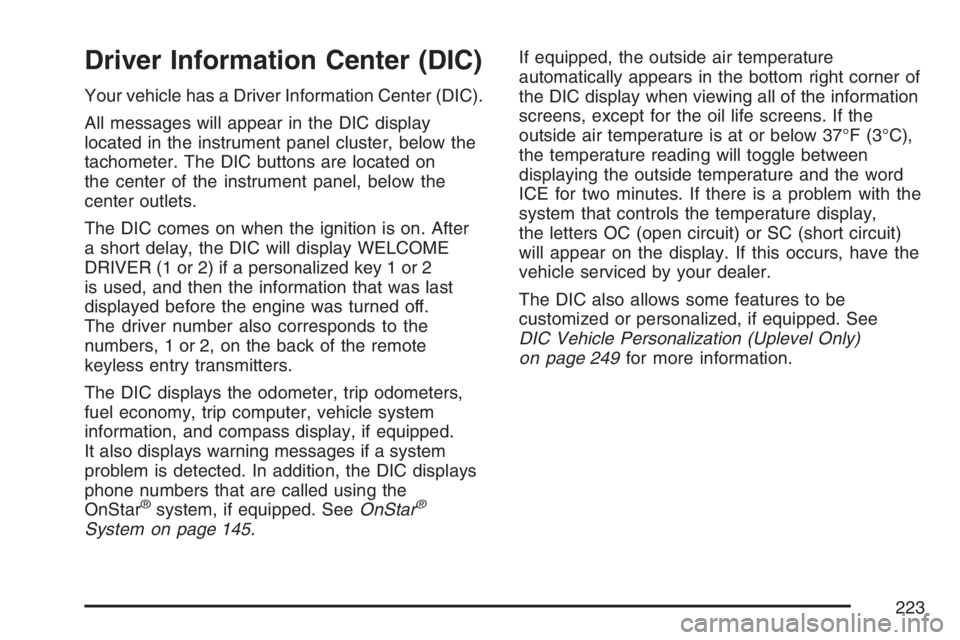
Driver Information Center (DIC)
Your vehicle has a Driver Information Center (DIC).
All messages will appear in the DIC display
located in the instrument panel cluster, below the
tachometer. The DIC buttons are located on
the center of the instrument panel, below the
center outlets.
The DIC comes on when the ignition is on. After
a short delay, the DIC will display WELCOME
DRIVER (1 or 2) if a personalized key 1 or 2
is used, and then the information that was last
displayed before the engine was turned off.
The driver number also corresponds to the
numbers, 1 or 2, on the back of the remote
keyless entry transmitters.
The DIC displays the odometer, trip odometers,
fuel economy, trip computer, vehicle system
information, and compass display, if equipped.
It also displays warning messages if a system
problem is detected. In addition, the DIC displays
phone numbers that are called using the
OnStar
®system, if equipped. SeeOnStar®
System on page 145.If equipped, the outside air temperature
automatically appears in the bottom right corner of
the DIC display when viewing all of the information
screens, except for the oil life screens. If the
outside air temperature is at or below 37°F (3°C),
the temperature reading will toggle between
displaying the outside temperature and the word
ICE for two minutes. If there is a problem with the
system that controls the temperature display,
the letters OC (open circuit) or SC (short circuit)
will appear on the display. If this occurs, have the
vehicle serviced by your dealer.
The DIC also allows some features to be
customized or personalized, if equipped. See
DIC Vehicle Personalization (Uplevel Only)
on page 249for more information.
223
Page 224 of 562
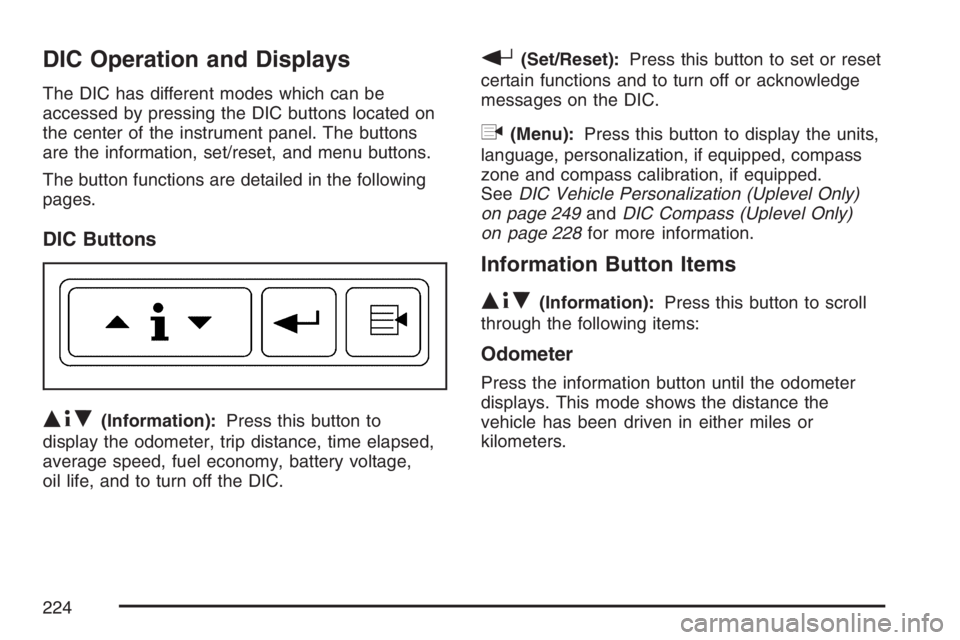
DIC Operation and Displays
The DIC has different modes which can be
accessed by pressing the DIC buttons located on
the center of the instrument panel. The buttons
are the information, set/reset, and menu buttons.
The button functions are detailed in the following
pages.
DIC Buttons
Q4R(Information):Press this button to
display the odometer, trip distance, time elapsed,
average speed, fuel economy, battery voltage,
oil life, and to turn off the DIC.
r(Set/Reset):Press this button to set or reset
certain functions and to turn off or acknowledge
messages on the DIC.
q(Menu):Press this button to display the units,
language, personalization, if equipped, compass
zone and compass calibration, if equipped.
SeeDIC Vehicle Personalization (Uplevel Only)
on page 249andDIC Compass (Uplevel Only)
on page 228for more information.
Information Button Items
Q4R
(Information):Press this button to scroll
through the following items:
Odometer
Press the information button until the odometer
displays. This mode shows the distance the
vehicle has been driven in either miles or
kilometers.
224
Page 225 of 562
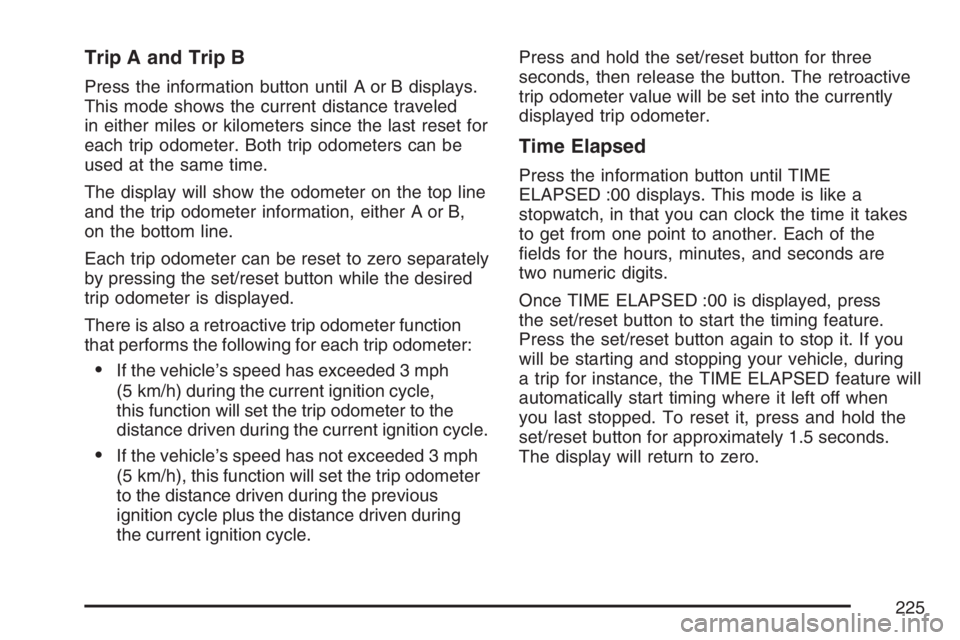
Trip A and Trip B
Press the information button until A or B displays.
This mode shows the current distance traveled
in either miles or kilometers since the last reset for
each trip odometer. Both trip odometers can be
used at the same time.
The display will show the odometer on the top line
and the trip odometer information, either A or B,
on the bottom line.
Each trip odometer can be reset to zero separately
by pressing the set/reset button while the desired
trip odometer is displayed.
There is also a retroactive trip odometer function
that performs the following for each trip odometer:
If the vehicle’s speed has exceeded 3 mph
(5 km/h) during the current ignition cycle,
this function will set the trip odometer to the
distance driven during the current ignition cycle.
If the vehicle’s speed has not exceeded 3 mph
(5 km/h), this function will set the trip odometer
to the distance driven during the previous
ignition cycle plus the distance driven during
the current ignition cycle.Press and hold the set/reset button for three
seconds, then release the button. The retroactive
trip odometer value will be set into the currently
displayed trip odometer.
Time Elapsed
Press the information button until TIME
ELAPSED :00 displays. This mode is like a
stopwatch, in that you can clock the time it takes
to get from one point to another. Each of the
�elds for the hours, minutes, and seconds are
two numeric digits.
Once TIME ELAPSED :00 is displayed, press
the set/reset button to start the timing feature.
Press the set/reset button again to stop it. If you
will be starting and stopping your vehicle, during
a trip for instance, the TIME ELAPSED feature will
automatically start timing where it left off when
you last stopped. To reset it, press and hold the
set/reset button for approximately 1.5 seconds.
The display will return to zero.
225
Page 466 of 562
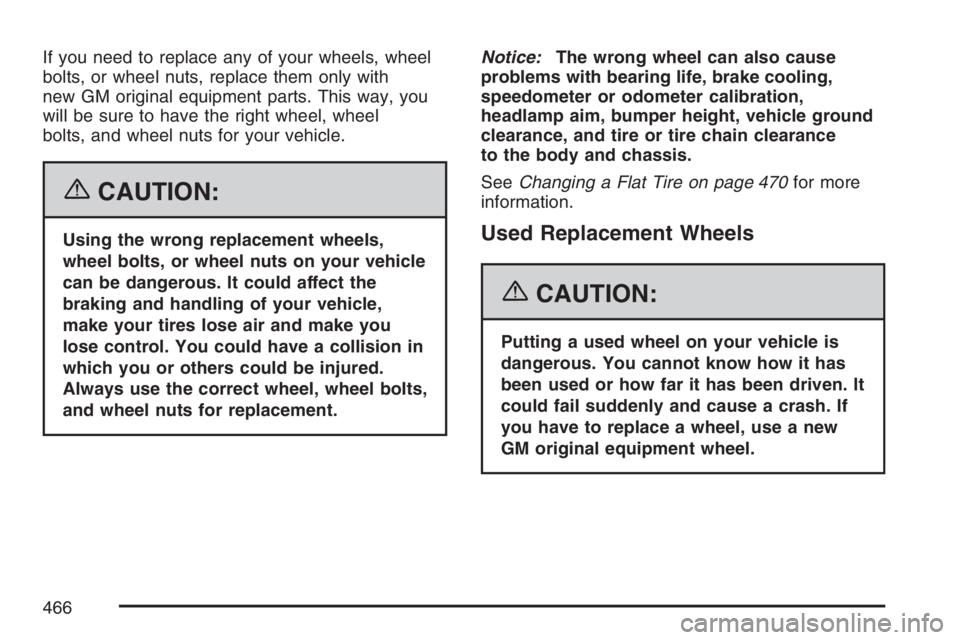
If you need to replace any of your wheels, wheel
bolts, or wheel nuts, replace them only with
new GM original equipment parts. This way, you
will be sure to have the right wheel, wheel
bolts, and wheel nuts for your vehicle.
{CAUTION:
Using the wrong replacement wheels,
wheel bolts, or wheel nuts on your vehicle
can be dangerous. It could affect the
braking and handling of your vehicle,
make your tires lose air and make you
lose control. You could have a collision in
which you or others could be injured.
Always use the correct wheel, wheel bolts,
and wheel nuts for replacement.Notice:The wrong wheel can also cause
problems with bearing life, brake cooling,
speedometer or odometer calibration,
headlamp aim, bumper height, vehicle ground
clearance, and tire or tire chain clearance
to the body and chassis.
SeeChanging a Flat Tire on page 470for more
information.Used Replacement Wheels
{CAUTION:
Putting a used wheel on your vehicle is
dangerous. You cannot know how it has
been used or how far it has been driven. It
could fail suddenly and cause a crash. If
you have to replace a wheel, use a new
GM original equipment wheel.
466
Page 522 of 562

Maintenance Record
After the scheduled services are performed, record the date, odometer reading, who performed the
service, and the type of services performed in the boxes provided. SeeMaintenance Requirements on
page 506. Any additional information fromOwner Checks and Services on page 514can be added on the
following record pages. You should retain all maintenance receipts.
Maintenance Record
DateOdometer
ReadingServiced ByMaintenanceIor
MaintenanceIIServices Performed
522
Page 523 of 562
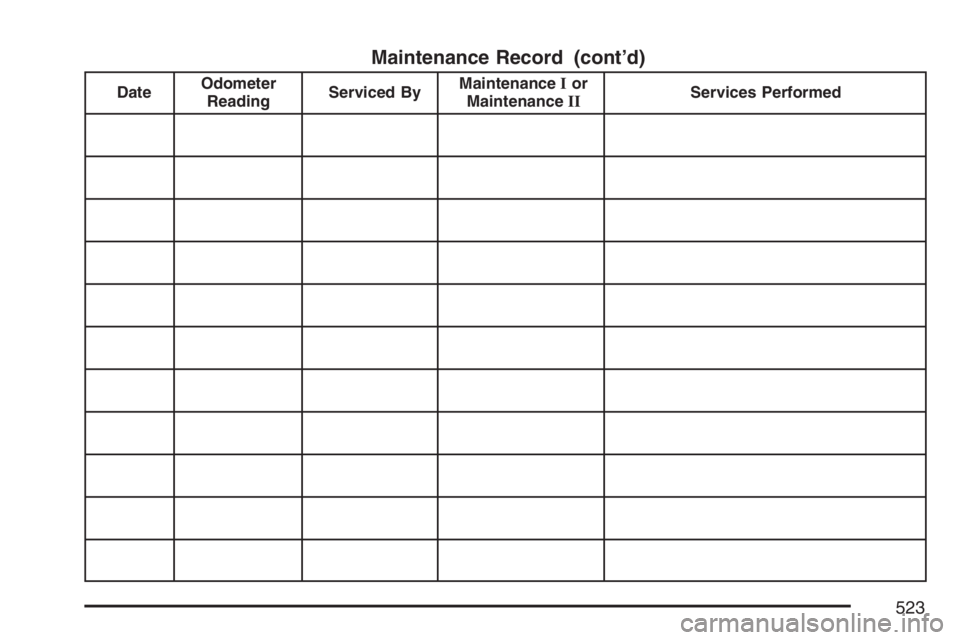
Maintenance Record (cont’d)
DateOdometer
ReadingServiced ByMaintenanceIor
MaintenanceIIServices Performed
523
Page 524 of 562
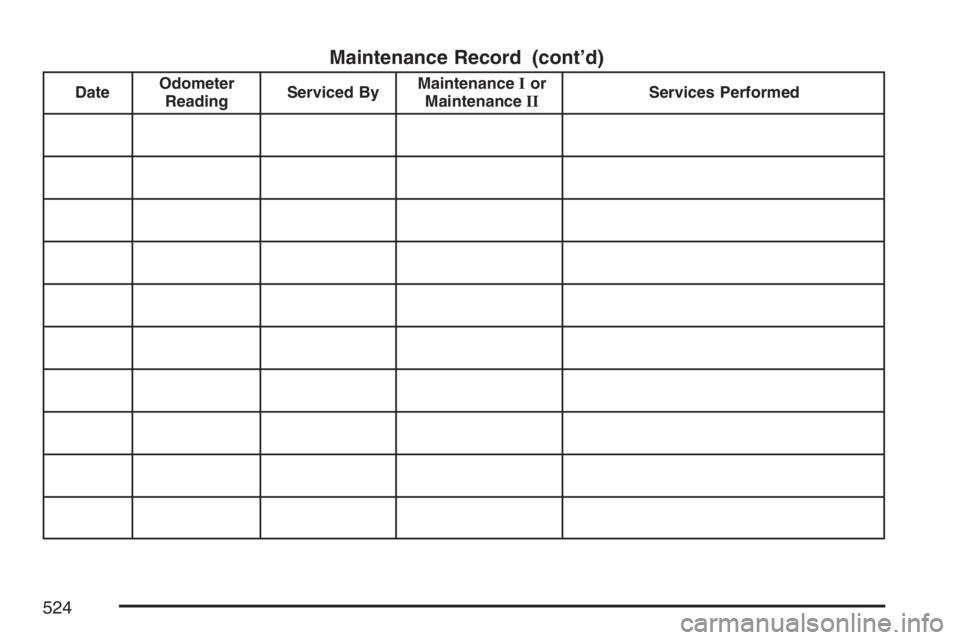
Maintenance Record (cont’d)
DateOdometer
ReadingServiced ByMaintenanceIor
MaintenanceIIServices Performed
524